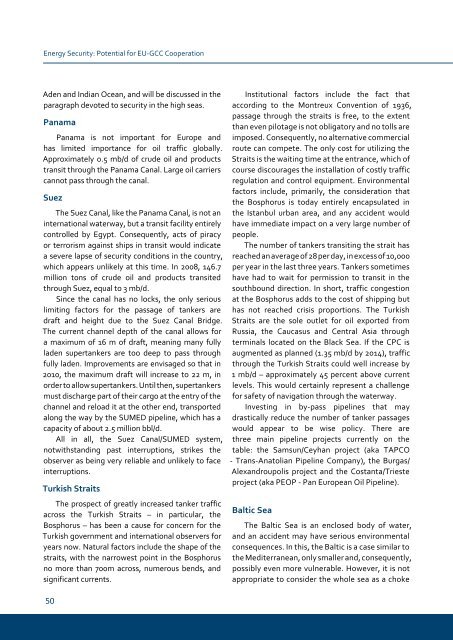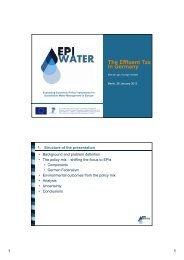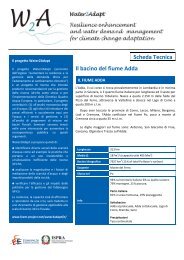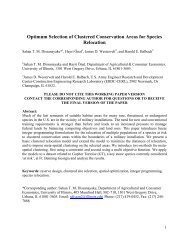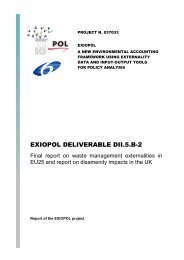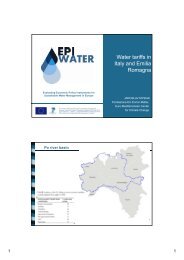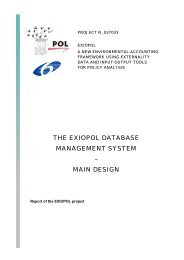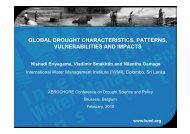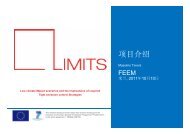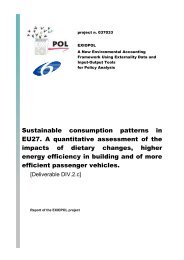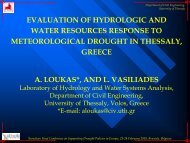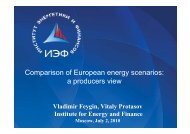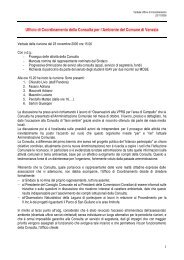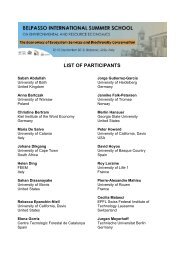Gulf and European Energy Supply Security - Feem-project.net
Gulf and European Energy Supply Security - Feem-project.net
Gulf and European Energy Supply Security - Feem-project.net
You also want an ePaper? Increase the reach of your titles
YUMPU automatically turns print PDFs into web optimized ePapers that Google loves.
<strong>Energy</strong> <strong>Security</strong>: Potential for EU-GCC Cooperation<br />
Aden <strong>and</strong> Indian Ocean, <strong>and</strong> will be discussed in the<br />
paragraph devoted to security in the high seas.<br />
Panama<br />
Panama is not important for Europe <strong>and</strong><br />
has limited importance for oil traffic globally.<br />
Approximately 0.5 mb/d of crude oil <strong>and</strong> products<br />
transit through the Panama Canal. Large oil carriers<br />
cannot pass through the canal.<br />
suez<br />
The Suez Canal, like the Panama Canal, is not an<br />
international waterway, but a transit facility entirely<br />
controlled by Egypt. Consequently, acts of piracy<br />
or terrorism against ships in transit would indicate<br />
a severe lapse of security conditions in the country,<br />
which appears unlikely at this time. In 2008, 146.7<br />
million tons of crude oil <strong>and</strong> products transited<br />
through Suez, equal to 3 mb/d.<br />
Since the canal has no locks, the only serious<br />
limiting factors for the passage of tankers are<br />
draft <strong>and</strong> height due to the Suez Canal Bridge.<br />
The current channel depth of the canal allows for<br />
a maximum of 16 m of draft, meaning many fully<br />
laden supertankers are too deep to pass through<br />
fully laden. Improvements are envisaged so that in<br />
2010, the maximum draft will increase to 22 m, in<br />
order to allow supertankers. Until then, supertankers<br />
must discharge part of their cargo at the entry of the<br />
channel <strong>and</strong> reload it at the other end, transported<br />
along the way by the SUMED pipeline, which has a<br />
capacity of about 2.5 million bbl/d.<br />
All in all, the Suez Canal/SUMED system,<br />
notwithst<strong>and</strong>ing past interruptions, strikes the<br />
observer as being very reliable <strong>and</strong> unlikely to face<br />
interruptions.<br />
turkish straits<br />
The prospect of greatly increased tanker traffic<br />
across the Turkish Straits – in particular, the<br />
Bosphorus – has been a cause for concern for the<br />
Turkish government <strong>and</strong> international observers for<br />
years now. Natural factors include the shape of the<br />
straits, with the narrowest point in the Bosphorus<br />
no more than 700m across, numerous bends, <strong>and</strong><br />
significant currents.<br />
0<br />
Institutional factors include the fact that<br />
according to the Montreux Convention of 1936,<br />
passage through the straits is free, to the extent<br />
than even pilotage is not obligatory <strong>and</strong> no tolls are<br />
imposed. Consequently, no alternative commercial<br />
route can compete. The only cost for utilizing the<br />
Straits is the waiting time at the entrance, which of<br />
course discourages the installation of costly traffic<br />
regulation <strong>and</strong> control equipment. Environmental<br />
factors include, primarily, the consideration that<br />
the Bosphorus is today entirely encapsulated in<br />
the Istanbul urban area, <strong>and</strong> any accident would<br />
have immediate impact on a very large number of<br />
people.<br />
The number of tankers transiting the strait has<br />
reached an average of 28 per day, in excess of 10,000<br />
per year in the last three years. Tankers sometimes<br />
have had to wait for permission to transit in the<br />
southbound direction. In short, traffic congestion<br />
at the Bosphorus adds to the cost of shipping but<br />
has not reached crisis proportions. The Turkish<br />
Straits are the sole outlet for oil exported from<br />
Russia, the Caucasus <strong>and</strong> Central Asia through<br />
terminals located on the Black Sea. If the CPC is<br />
augmented as planned (1.35 mb/d by 2014), traffic<br />
through the Turkish Straits could well increase by<br />
1 mb/d – approximately 45 percent above current<br />
levels. This would certainly represent a challenge<br />
for safety of navigation through the waterway.<br />
Investing in by-pass pipelines that may<br />
drastically reduce the number of tanker passages<br />
would appear to be wise policy. There are<br />
three main pipeline <strong>project</strong>s currently on the<br />
table: the Samsun/Ceyhan <strong>project</strong> (aka TAPCO<br />
- Trans-Anatolian Pipeline Company), the Burgas/<br />
Alex<strong>and</strong>roupolis <strong>project</strong> <strong>and</strong> the Costanta/Trieste<br />
<strong>project</strong> (aka PEOP - Pan <strong>European</strong> Oil Pipeline).<br />
Baltic sea<br />
The Baltic Sea is an enclosed body of water,<br />
<strong>and</strong> an accident may have serious environmental<br />
consequences. In this, the Baltic is a case similar to<br />
the Mediterranean, only smaller <strong>and</strong>, consequently,<br />
possibly even more vulnerable. However, it is not<br />
appropriate to consider the whole sea as a choke


